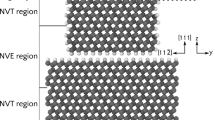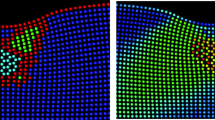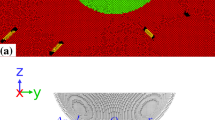Abstract
The rolling resistance of a sphere on an atomically flat surface was studied by molecular dynamics simulation carried out by rolling a rigid Ni sphere on a copper (100) surface. Spheres of 6 and 12 nm diameters were used for rolling simulations after indentation up to 10 Å in depth and the computations carried out using embedded atom potentials of Ni and Cu, assuming either active molecular interaction at the contacts (normal potentials) or the presence of a passivation layer on the sphere. Results showed that the sphere size, penetration depth, and adhesion at the rolling interface strongly affected the rolling friction. When molecular interactions were allowed at the rolling contacts, the average rolling friction coefficient was higher and severe oscillations in the friction force was observed. On the other hand, a sphere with a passivation layer produced more dislocations in the copper substrate during rolling and the motion of the dislocations affected the coefficient of rolling friction and the size of the friction force oscillations. This work also suggested that rolling friction at the nanoscale level was similar to the macroscopic rolling condition during strain hardening of metals due to severe dislocation multiplication underneath the nanosphere in nanorolling.






Similar content being viewed by others
References
Eldredge, K.R., Tabor, D.: The mechanism of rolling friction. I. The plastic range. Proc. R. Soc. Lond. 229, 181–198 (1955)
Tabor, D.: The mechanism of rolling friction. II. The elastic range. Proc. R. Soc. Lond. 229, 198–220 (1955)
Greenwood, J.A., Minshall, H., Tabor, D.: Hysteresis losses in rolling and sliding friction. Proc. R. Soc. Lond. 259, 480–507 (1961)
Bowden, F.P., Tabor, D.: The Friction and Lubrication of Solids. Oxford University Press, Oxford (1968)
Stachowiak, G.W., Batchelor, A.W.: Engineering Tribology, 2nd edn. Butterworth-Heinmann, Oxford (2001)
Bhushan, B.: Introduction to Tribology. Wiley, New York (2002)
Johnson, K.L.: Contact Mechanics. Cambridge University Press, Cambridge (1985)
Kendal, K.: Rolling friction and adhesion between smooth solids. Wear 33, 351–358 (1975). doi:10.1016/0043-1648(75)90288-4
Blom, D.G., Bueche, A.M.: Theory of rolling friction for spheres. J. Appl. Phys. 30, 1725–1730 (1959). doi:10.1063/1.1735043
Bueche, A.M., Blom, D.G.: Surface friction and dynamic mechanical properties of polymers. Wear 2, 168–182 (1958/1959). doi:10.1016/0043-1648(59)90002-X
Reynolds, O.: On rolling friction. Philos. Trans. R. Soc. Lond. 166, 155–174 (1876). doi:10.1098/rstl.1876.0006
Tomlinson, G.: The molecular theory of friction. Philos. Mag. 7, 905–916 (1929)
Heathcote, H.L.: The ball bearing: in the making, under test and on service. Proc. Inst. Auto. Eng. 15, 569–702 (1921)
Jeng, Y., Tsai, P., Fang, T.: Molecular dynamics studies of atomic-scale friction for roller-on-slab systems with different rolling-sliding conditions. Nanotechnology 16, 1941–1949 (2005). doi:10.1088/0957-4484/16/9/087
Schall, J.D., Brenner, D.W.: Molecular dynamics simulations of carbon nanotube rolling and sliding on graphite. Mol. Simul. 25, 73–79 (2000). doi:10.1080/08927020008044113
Heo, S., Sinnott, S.B.: Effect of molecular interactions on carbon nanotube friction. J. Appl. Phys. 102, 064307-1-6 (2007)
Bhushan, B., Ling, X., Jungen, A., Hierold, C.: Adhesion and friction of a multi-walled carbon nanotube sliding against single-walled carbon nanotube. Phys. Rev. B 77, 165428-1-12 (2008)
Falvo, M.R., Taylor II, R.M., Helser, A., Chi, V., Brooks Jr., F.P., Washburn, S., Superfine, R.: Nanometer-scale rolling and sliding of carbon nanotubes. Nature 397, 236–238 (1999). doi:10.1038/16662
Haile, J.M.: Molecular dynamics simulation. Wiley, New York (1992)
Foils, S.M., Baskes, M.I., Daw, M.S.: Embedded-atom-potential functions for the fcc metals Cu, Ag, Au, Ni, Pd, Pt and their alloys. Phys. Rev. B 33, 7983–7991 (1986). doi:10.1103/PhysRevB.33.7983
Jang, H., Farkas, D.: Interaction of lattice dislocations with a grain boundary during nanoindentation simulation. Mater. Lett. 61, 868–871 (2007). doi:10.1016/j.matlet.2006.06.004
Luan, B., Robbins, M.O.: The breakdown of continuum models for mechanical contacts. Nature 435, 929–932 (2005). doi:10.1038/nature03700
Rabinowicz, E.: Friction and Wear of Materials, 2nd edn. Wiley, New York (1995)
Corcran, S.G., Colton, R.J., Lilleodden, E.T., Gerberich, W.W.: Anomalous plastic deformation at surfaces: nanoindentation of gold single crystals. Phys. Rev. B 55, R16057 (1997). doi:10.1103/PhysRevB.55.R16057
Kim, K.J., Yoon, J.H., Cho, M.H., Jang, H.: Molecular dynamics simulation of dislocation behavior during nanoindentation on a bicrystal with a Σ = 5 (210) grain boundary. Mater. Lett. 60, 3367–3372 (2006). doi:10.1016/j.matlet.2006.03.020
Acknowledgments
This work was supported by the Korea Science and Engineering Foundation (KOSEF) through the National Research Lab. Program funded by the Ministry of Science and Technology (N. R0A-2007-000-10011-0).
Author information
Authors and Affiliations
Corresponding author
Rights and permissions
About this article
Cite this article
Lee, W.G., Cho, K.H. & Jang, H. Molecular Dynamics Simulation of Rolling Friction Using Nanosize Spheres. Tribol Lett 33, 37–43 (2009). https://doi.org/10.1007/s11249-008-9389-z
Received:
Accepted:
Published:
Issue Date:
DOI: https://doi.org/10.1007/s11249-008-9389-z




